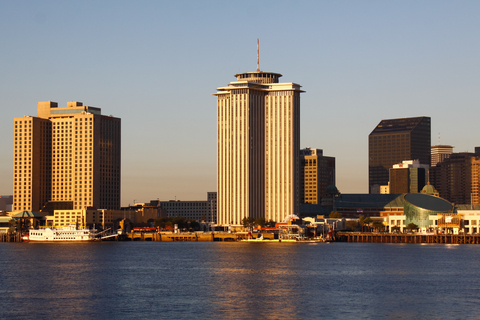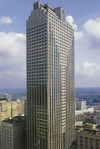
[Updated Oct 2020] A guide to executive suites and office space for rent in New Orleans as well as general information that may be useful if you are thinking of renting offices in New Orleans.
For further New Orleans offices information or to search office space for rent in New Orleans just click. Or contact us for any office space search inquiry.
History & Geography
New Orleans is one of the largest ports in the US and one of the most famous and iconic cities in the world. Named after the Duke of Orleans, the city lies on the banks of the mighty Mississippi River 100 miles upriver from the Gulf of Mexico. New Orleans lies on both east and west banks of the river slightly south of Lake Pontchartrain. The city was founded in 1718 by the French Mississippi Company under Jean-Baptiste Le Moyne de Bienville. The city played a decisive role in the American Revolutionary War funnelling supplies to the rebels and as a staging point for French military action. In 1803 Napoleon sold the entire territory of Louisiana to the US, including New Orleans. After the sale, the city’s population grew rapidly with an influx of immigrants. New Orleans became a prosperous port as well as an agricultural centre, with extensive plantations surrounding the city. During the War of 1812, New Orleans was the site of the last major battle of the war, a decisive victory for the American forces. Afterwards, the city continued to be one of the country’s most important ports and played a major role in the slave trade. During the Civil War, the city was captured fairly early on by Union forces and was thus spared the destruction that many other Southern cities experienced. After the war, the city continued to prosper though was afflicted by racial tension well into the 20th century. And as the 20th century dawned the city became eclipsed by others in the region such as Houston, Dallas and Atlanta. The city’s port remained one of the largest in the nation, though it shed jobs due to automation. New Orleans became very dependent on tourism and poverty and rising crime levels became problems.
Hurricane Katrina
In 2005 New Orleans was directly hit by Hurricane Katrina with disastrous results. The protections from floods which had been put into place completely failed to lead to what has been called the worst civil engineering disaster in US history. Over 80 percent of the city was flooded and more than 1,500 people died. Some are still missing. Tens of thousands of residents had to be evacuated from the city and the damage ran into the billions. Currently, the city’s population is only two-thirds of what it was before the hurricane and reconstruction is still continuing.
Economy
Much of New Orleans’ economy still revolves around its port which is one of the largest and most active in the world. The port handles 62 million tonnes of cargo every year and has the longest wharf in the world – over two miles. The city is also home to many ship-building enterprises as well as freight and cargo movers and assorted logistics companies. Among the largest companies of this type are Northrop Grumman Ship Systems, Trinity Yachts and Expeditors International. New Orleans is also home to a growing number of creative industries, many of them based in the city centre. The federal government is also a significant employer in the city, with NASA maintaining a large facility in the eastern part of New Orleans. Tourism is another bulwark of the local economy, with New Orleans being among the most famous tourist destinations in the country.
Tourism & Culture
Among New Orleans’ most popular tourist attractions perhaps the most visited is the city’s French Quarter, also known as the Vieux Carre. It is the oldest quarter of the city and is a National Historic Landmark. Bourbon Street is the most famous area of the French Quarter, and is renowned for its nightlife, featuring restaurants, bars, clubs and strip clubs. Before Hurricane Katrina hit, over ten million tourists flocked to New Orleans every year, and it was routinely ranked first on the list of the country’s top ten tourist destinations. The New Orleans Mint, which has now been turned into a museum is another popular tourist destination, as is the National World War II Museum, which features many displays covering the invasion of Normandy. Tours of the port on the Natchez, an authentic paddle steamer are another activity which is popular for tourists. New Orleans is also famous for its cemeteries, including the St Louis Cemetery which is famous for its resemblance to the Pere Lachaise Cemetery in Paris.
Transportation
New Orleans is served by the Louis Armstrong New Orleans International Airport which is in the Kenner district of the city. The city itself is fairly well served by public transportation. It has three streetcar lines, which are the oldest running streetcars in the nation. There is also an efficient bus system which serves most districts of the city. Because of its flat landscape bicycling is a very popular form of transport in the city and it is ranked number eight for its rate of bicycle transport.
Office space for rent in New Orleans
At the end of last year, the vacancy rate in New Orleans was approximately 13.3 percent. For Class A offices the vacancy rate rose to 14 percent. On average the rental rate for New Orleans office space is USD 15.78 per square foot. In the last two years, two new developments have come on the market, totalling 46,716 square feet. Currently, the city has a fairly low rate of unemployment, but it also has a very slow rate of jobs growth. Additionally, there are few projects in the pipeline which may result in higher rents over the next few years, analysts have predicted.
Our office space search, advisory and acquisition services are FREE, always. Our New Orleans office space brokers and agents are globally regulated by the Royal Institution of Chartered Surveyors (RICS) ensuring the highest standards of commercial property advice and service at all times.

The Office Providers is Regulated by the RICS
